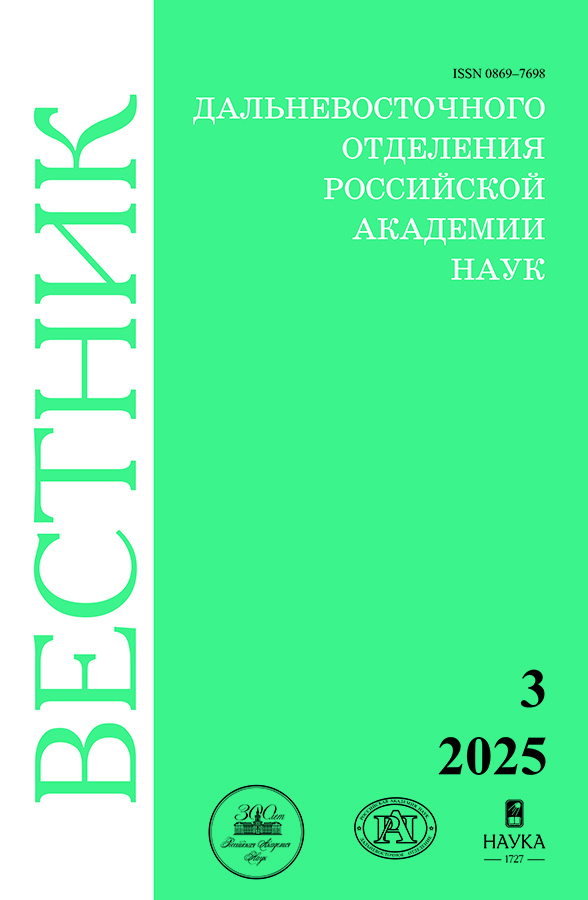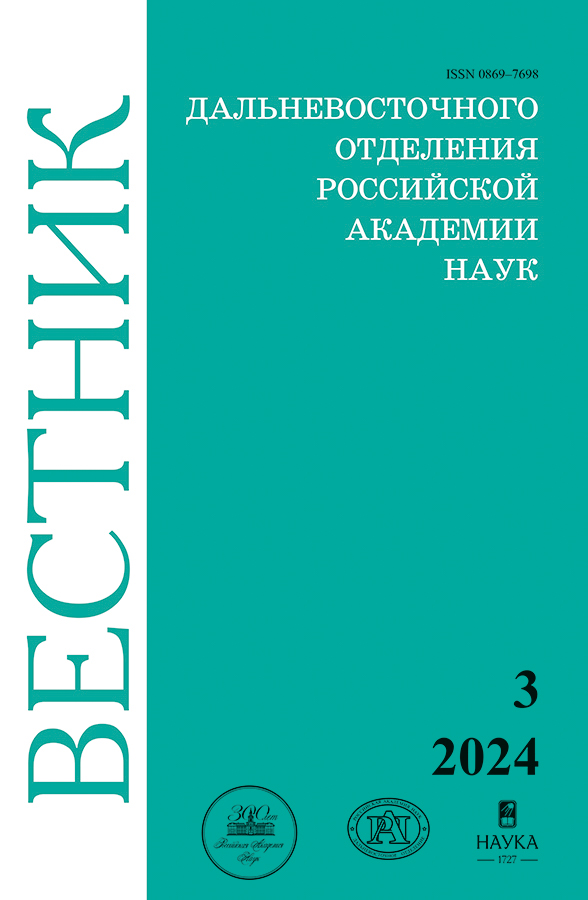№ 3 (2024)
Химические науки. К 60-летию Тихоокеанского института биоорганической химии им. Г.Б. Елякова ДВО РАН
Нам шестьдесят: вехи долгой жизни
Аннотация
В этом году Тихоокеанский институт биоорганической химии им. Г.Б. Елякова (ТИБОХ) отмечает свое 60-летие и 95-летие его основателя – выдающегося ученого и организатора науки академика Г.Б. Елякова. Краткие сведения об истории ТИБОХ, его замечательных ученых, некоторых значимых научных результатах и роли Института в мировых исследованиях природных биологически активных соединений приводятся в предложенном сообщении.
 5-7
5-7


Научная школа академика В.А. Стоника, лауреата высшей награды ДВО РАН «Золотая медаль им. В.Л. Комарова» за 2023 год
Аннотация
В статье приведены некоторые сведения об одной из самых больших научных школ на Дальнем Востоке России, созданной академиком РАН Валентином Ароновичем Стоником, награжденным высшей наградой ДВО РАН «Золотая медаль им. В.Л. Комарова» 2023 г. за многолетний добросовестный труд, высокий профессионализм и выдающийся вклад в развитие научных исследований на Дальнем Востоке России в области теоретических и прикладных вопросов биоорганической химии.
 8-11
8-11


Морские природные продукты: долгий путь к открытию лекарств
Аннотация
Сотрудничество между научно-исследовательскими институтами Южной Кореи и Тихоокеанским институтом биоорганической химии имени Г.Б. Елякова (ТИБОХ) в России началось 30 лет назад, в 1993 году. С тех пор мы активно ведем исследования в области морской биотехнологии и фармацевтики. На протяжении почти 20 лет это успешное партнерство возглавлял выдающийся “дирижер” профессор Валентин Стоник, сформировавший изысканный гармоничный “оркестр”, который мы назвали KORUS MUSIC (Korea-Russia collaboration for Marine Unlimitedre Sources for Innovation and Creation). Цель данной обзорной статьи – рассказать об истории создания KORUS MUSIC и отметить значительные успехи, достигнутые в ходе наших совместных исследований, а также наметить планы нашего дальнейшего сотрудничества и совместных усилий на ближайшие 20 лет.
 12-36
12-36


Химические науки. Биоорганическая химия
Фуканазы 107 структурного семейства морской бактерии Wenyingzhuangia fucanilytica CZ1127Т
Аннотация
Работа посвящена обобщению и сравнению структурной организации, физико-химических свойств и субстратной специфичности четырех фуканаз 107 семейства гликозидгидролаз, входящих в состав фукоиданутилизирующего кластера морской бактерии Wenyingzhuangia fucanilytica CZ1127Т. Установленные различия в значимых характеристиках этих ферментов дают новые знания об особенностях фуканаз, принадлежащих семейству GH107.
 37-56
37-56


Бурая водоросль Costaria costata – перспективный источник питательных веществ и биологически активных соединений
Аннотация
Бурые водоросли являются богатым источником основных питательных веществ, включая углеводы, белки, минералы, полиненасыщенные липиды, а также ряд других полезных для здоровья соединений, способных воздействовать на широкий спектр заболеваний. Представлен обзор химического состава бурой водоросли Costaria costata, биологической активности выделенных из нее полисахарида фукоидана и флоротаннина – соединений, характерных только для бурых водорослей, а также эффектов, связанных с их потреблением.
 57-68
57-68


Исследование структур тритерпеновых гликозидов и стеринов из голотурий в Тихоокеанском институте биоорганической химии им. Г.Б. Елякова ДВО РАН. Последние достижения
Аннотация
Кратко обсуждаются основные достижения в исследовании строения тритерпеновых гликозидов и стеринов голотурий в Тихоокеанском институте биоорганической химии им. Г.Б. Елякова ДВО РАН в период с 2019 г. по настоящее время, главным из которых является выделение и установление структуры более 80 новых тритерпеновых гликозидов из тихоокеанских голотурий, причем ряд из них обладает уникальными структурными чертами.
 69-89
69-89


Тритерпеновые гликозиды растений рода Panax
Аннотация
В настоящем обзоре рассмотрены химические свойства тритерпеновых гликозидов, выделенных из растений рода Panax. Приведены тривиальные, сокращенные и систематические названия гликозидов, наиболее употребляемые в настоящее время.
 90-100
90-100


Лаборатория химии пептидов Тихоокеанского института биоорганической химии ДВО РАН им. Г.Б. Елякова: сорок лет исследований пептидов и белков морских анемон
Аннотация
В обзоре кратко описаны исследования, проводившиеся в течение последних 40 лет в лаборатории химии пептидов Тихоокеанского института биоорганической химии ДВО РАН (ЛХП ТИБОХ ДВО РАН) в сотрудничестве с российскими и зарубежными коллегами. Обсуждаются результаты поиска, идентификации и изучения структуры, биологической активности и механизмов взаимодействия с биологическими мишенями пептидов и полипептидов, продуцируемых тропической морской анемоной Heteractis crispa (=Heteractis magnifica, ранее Radianthus macrodactylus). Одним из основных достижений лаборатории за прошедшие годы является открытие нового структурного типа 2 нейротоксинов, а именно шести токсинов, которые в первое десятилетие зарубежных исследований (70–80-е годы прошлого столетия) не были идентифицированы среди представителей так называемых длинных анемонотоксинов, и среди них – первого, ранее неизвестного, двухцепочечного нейротоксина. Кроме того, установлено наличие нескольких мультигенных семейств, экспрессирующих a-пороформирующие токсины (актинопорины), ингибиторы сериновых протеаз (пептиды Кунитц-типа) и APETx-подобные пептиды, образующих комбинаторные библиотеки, насчитывающие по нескольку десятков высокогомологичных представителей семейства. Методами in silico (гомологичное моделирование, аланиновый мутагенез, полноатомная молекулярно-динамическая (МД) симуляция) впервые предсказаны пространственные структуры исследуемых пептидов и комплексов с биологическими мишенями, проведен анализ их структурно-функциональных взаимоотношений. Это явилось основой для дальнейшего получения на базе комбинаторных библиотек рекомбинантных и мутантных аналогов с целью проведения электрофизиологических исследований механизмов их молекулярного взаимодействия с мишенями, а также определения фармакологического потенциала. В обзоре кратко представлены наиболее важные результаты последних лет, связанные с открытием у ряда исследуемых пептидов анальгетической, противовоспалительной и противоопухолевой активности.
 101-120
101-120


Химические науки. Молекулярная фармакология
Лаборатория биоиспытаний и механизма действия биологически активных веществ: недавние достижения в исследованиях биологически активных соединений
Аннотация
Основное научное направление лаборатории биоиспытаний и механизма действия биологически активных веществ Тихоокеанского института биоорганической химии им. Г.Б. Елякова ДВО РАН – изучение биологической активности природных и синтетических соединений. В обзоре кратко рассматриваются основные достижения лаборатории за последние пять лет.
 121-142
121-142


Химические науки. Молекулярная иммунология
Структурное разнообразие и свойства углеводсодержащих биополимеров морских грамотрицательных бактерий
Аннотация
Представлены результаты исследований капсульных полисахаридов и липополисахаридов морских грамотрицательных бактерий, принадлежащих к родам Pseudoalteromonas, Idiomarina, Marinicella, Halomonas, Cobetia, Poseidonocella, Psychrobacter, Devosia, Echinicola и Cellulophaga.
 143-164
143-164


Роботы, мехатроника и робототехнические системы
Особенности выполнения технологических операций с помощью автономных необитаемых подводных аппаратов, оснащаемых многозвенными манипуляторами
Аннотация
Описан новый обобщенный подход к выполнению подводных контактных (технологических) операций в полностью автоматическом режиме с помощью автономных необитаемых подводных аппаратов, оснащенных многозвенными манипуляторами. Данный подход предполагает использование специального корпуса подводного аппарата, обеспечивающего его высокую мобильность и удобное управление по всем шести степеням свободы, а также пассивную стабилизацию по вертикали при выполнении контактных операций с помощью шестистепенного манипулятора. Предложенный новый метод идентификации присоединяемых к движущимся звеньям манипулятора масс и моментов инерции жидкости, а также коэффициентов вязкого трения позволяет определить внешние моменты в сочленениях манипулятора, обеспечивающие точное силовое воздействие его рабочего инструмента на объекты работ. Поддержание этого заданного воздействия обеспечивается специальной системой стабилизации положения и ориентации аппарата в заданной точке пространства, а также текущими тягами его движителей с учетом фактической конфигурации манипулятора. Предлагаемые методы, а также синтезированные на их основе устройства и системы с элементами искусственного интеллекта частично уже апробированы на наземных и подводных робототехнических комплексах, что гарантирует их успешное использование при создании манипуляционных автономных подводных аппаратов нового поколения.
 165-177
165-177








